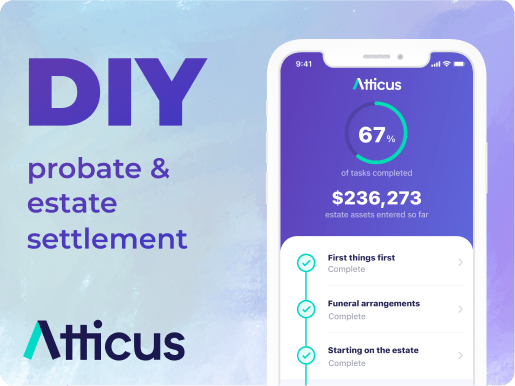Waive Of Notice
Everything you need to know about Montana Form Form 3.5, including helpful tips, fast facts & deadlines, how to fill it out, where to submit it and other related MT probate forms.


About Waive Of Notice
There are all sorts of forms executors, beneficiaries, and probate court clerks have to fill out and correspond with during probate and estate settlement, including affidavits, letters, petitions, summons, orders, and notices.
Waive Of Notice is a commonly used form within Montana. Here’s an overview of what the form is and means, including a breakdown of the situations when (or why) you may need to use it:
Atticus Fast Facts About Waive Of Notice
Sometimes it’s tough to find a quick summary— here’s the important details you should know about Waive Of Notice:
This form pertains to the State of Montana
Government forms are not typically updated often, though when they are, it often happens rather quietly. While Atticus works hard to keep this information about Montana’s Form Form 3.5 - Waive Of Notice up to date, certain details can change from time-to-time with little or no communication.
How to file Form Form 3.5
Step 1 - Download the correct Montana form based on the name and ID if applicable
Double check that you have both the correct form name and the correct form ID. Some Montana probate forms can look remarkably similar, so it’s best to double, even triple-check that you’re using the right one! Keep in mind that not all States have a standardized Form ID system for their probate forms.
Step 2 - Complete the Document
Fill out all relevant fields in Form Form 3.5, take a break, and then review. Probate and estate settlement processes in MT are long enough to begin with, and making a silly error can push your timeline even farther back. No thank you!
Note: If you don’t currently know all of the answers and are accessing Form Form 3.5 online, be sure to avoid closing the browser tab and potentially losing all your progress (or use a platform like Atticus to help avoid making mistakes).
Step 3 - Have Form Form 3.5 witnessed or notarized (if required)
Some States and situations require particular forms to be notarized. If you have been instructed to get the document notarized or see it in writing on the document, then make sure to hire a local notary. There are max notary fees in the United States that are defined and set by local law. Take a look at our full guide to notary fees to make sure you aren’t overpaying or getting ripped off.
Step 4 - Submit Waive Of Notice to the relevant office
This is most often the local probate court where the decedent (person who passed away) is domiciled (permanently resides) or the institution involved with this particular form (e.g. a bank). Some offices allow you to submit forms online, other’s don’t, and we while we generally recommend going in-person to expedite the process, sometimes that simply isn’t an option.
It’s also a generally good idea to establish a positive working relationship with any probate clerk (unfortunately there’s enough people & process out there making things more difficult and unnecessarily confusing for them), so a best practice is to simply ask the probate clerk proactively exactly how and where they’d prefer you to submit all forms.
Need help getting in touch with a local probate court or identifying a domicile probate jurisdiction?
👉 Find and Contact your Local Probate Court
👉 What is a Domicile Jurisdiction?

Sponsored by Atticus App
Need help with Montana Probate?
Join all the other families who have trusted Atticus through probate, and experience the peace that comes from knowing you're taking the right steps, spending the least amount of money, and not wasting a single second.
When Waive Of Notice is due
Different probate forms or processes can require different deadlines or response times for completing the appropriate form.
While some steps in the process are bound to specific deadlines (like petitioning for probate, having to submit an inventory of assets, or filing applicable notices to creditors and beneficiaries), many probate forms or processes are not tied to a specific deadline since the scope of work can vary based on situational factors or requirements involved.
Either way, there are a bunch of practical reasons why personal representatives should work to complete each step as thoroughly and quickly as possible when completing probate in Montana.
5 reasons you should submit Form 3.5 as quickly as possible:
The sooner you begin, the faster Montana can allow heirs and beneficiaries to get their share of assets subject to probate. Acting promptly can also decrease the costs & overall mental fatigue through an otherwise burdensome process.
Helpful Context: What’s the Difference Between Probate and Non-Probate Assets?In general, creditors of an estate usually have around 3-6 months from the time you file notice to creditors to file any claims for debt against the deceased’s assets. If they don’t, then that debt is forfeited (and more importantly, the executor won’t be held personally responsible). So doing this sooner means you have a better idea of who is owed what and ensures you won’t get a surprise collector months later.
Not filing a will within 30 days (on average) could mean that the probate process proceeds according to intestate laws (laws that govern what happens to someone's stuff without a will) or is subject to unnecessary supervision by the probate court. And if you aren't directly related to the deceased (a.k.a. next of kin), this could also mean you lose your inheritance.
It’s important to file any necessary state tax returns on behalf of the deceased or estate by the following tax season in Montana. If you don’t, you could owe penalties and interest. This also includes any necessary federal tax returns such as Forms 1040, 1041, or even a Form 706 estate tax return.
If a house in the State of Montana is left empty (or abandoned) for a while, insurance can get dicey. For example, if the house burns down and no one has been there for a year, an insurance company may get out of paying your claim.
If you’re not using Atticus to get specific forms, deadlines, and timelines for Montana probate, then try and stay as organized as possible, pay close attention to the dates mentioned in any correspondence you have with the State’s government officials, call the local Montana probate clerk or court for exact answers regarding Form Form 3.5, and when in doubt— consult a qualified trust & estates lawyer for that area.
How to Download, Open, and Edit Form Form 3.5 Online
Waive Of Notice is one of the many probate court forms available for download through Atticus.
It may also be available through some Montana probate court sites, such as . In order to access the latest version, be updated with any revisions, and get full instructions on how to complete each form, check out the Atticus Probate & Estate Settlement software or consider hiring a qualified legal expert locally within Montana.
While Atticus automatically provides the latest forms, be sure to choose the correct version of Form Form 3.5 - Waive Of Notice f using any other site or resource in order to avoid having to re-complete the form process and/or make another trip to the Montana probate court office.
Waive Of Notice is a .pdf, so opening it should be as simple as clicking “View Form” from within the Atticus app or by clicking the appropriate link found on any Montana-provided government platform. Once you’ve opened the form, you should be able to directly edit the form before saving or printing.
Did you know?
Form Form 3.5 - Waive Of Notice is a probate form in Montana.
Montana has multiple types of probate and the necessary forms depend on the unique aspects of each estate, such as type and value of assets, whether there was a valid will, who is serving as the personal representative or executor, and even whether or not they also live in Montana.
During probate, all personal representatives and executives in are required to submit a detailed inventory of assets that must separate non-probate assets from probate assets.
Probate in Montana, especially without guidance, can take years to finish and cost upwards of $14,000.
Frequently Asked Questions about Waive Of Notice
What is probate, exactly?
Probate is the government’s way of making sure that when a person dies, the right stuff goes to the right people (including the taxes the government wants).
All of that stuff is collectively known as someone’s “estate”, and it’s the job of the executor or personal representative to fill out all the forms and complete all the required steps to formally dissolve the estate.
To get instant clarity on the entire probate process and get an idea of the steps, timeline, and best practices, read the Atticus Beginner’s Guide to Probate.
Where can I get help with Probate?
The best place? Create an account in Atticus to start getting estate-specific advice.
You may need a lawyer, you may not, and paying for one when you didn’t need it really hurts. Atticus makes sure you make the best decisions (plus you can write it off as an executor expense).
We’ve also created a list of other probate services. Be sure to check it out!
What does a MT executor or personal representative have to do?
An executor is named in someone’s will, and if the deceased didn’t have a will, then the spouse or other close family relative usually steps up to fulfill the role. If no one wants to do it, then a judge will appoint someone.
The executor is responsible for the complete management of the probate process, including major responsibilities such as:
Creating an inventory of all probate assets.
Filling out all necessary forms
Paying off all estate debts and taxes
Submitting reports to the court and beneficiaries as requested
And much more. This process often stretches longer than a year.
For an idea of what separates executors who succeed from those who make this way harder than it should be, visit our article, Executors of an Estate:
What they do & secrets to succeeding.
The Exact Text on Form Form 3.5
Here’s the text, verbatim, that is found on Montana Form Form 3.5 - Waive Of Notice. You can use this to get an idea of the context of the form and what type of information is needed.
Form 3.5 WAIVER OF NOTICE - PAGE -1 § 72-3-302, MCA (2005) 1 2 3 4 5 6 7 8 9 10 11 12 13 14 15 16 17 18 19 20 21 22 23 24 25 26 27 28 MONTANA JUDICIAL DISTRICT COURT, COUNTY IN THE MATTER OF THE ESTATE OF , Deceased. Probate No. WAIVER OF NOTICE The undersigned, as a party interested in the above estate and pursuant to § 72-1-302, MCA (2005), hereby waives such notice as is provided by law for the following proceedings: [Specify proceeding affected] DATED this _____ day of _________________, 20___. Name or attorney’s name:________________ Address: _____________________________ _____________________________ Attorney Name: ______________________________________ ATTORNEY'S LAW FIRM: _____________________________ Attorney's Address: __________________________________ Phone Number: _____________________________________ Attorneys for: _______________________________________ ______________________________________________________________________

Need help finding the rest of your Montana Probate forms?
View allMontana probate forms.
Need step-by-step guidance? Let Atticus help find and recommend necessary forms to help you through the process with full confidence— from start to finish.




